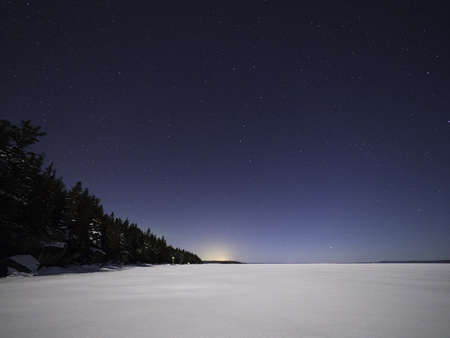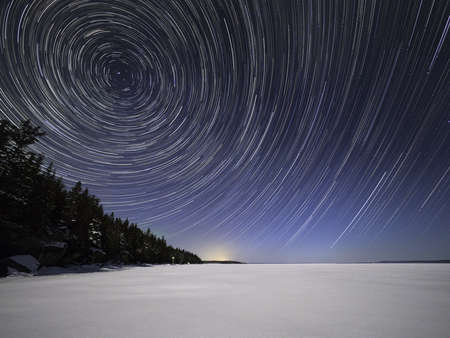8 Tips for Moonlit Landscapes
One of the most common questions that I get as a photographer is how to properly shoot the moon. That question seems to pop up quite regularly - once per month in fact, when the moon is full. People love photographing the full moon, but once the event is over there seems to be far less interest in capturing our closest neighbour. I certainly understand this thinking. The full moon, especially when it is rising, can be an impressive (and somewhat challenging) subject to photograph.

As a landscape photographer I am always looking for interesting ways to present a scene. And like most, I work primarily during the two bookends of the day - the golden hours. But, as someone who also enjoys astrophotography, I have discovered that I can extend my landscape opportunities by shooting under the light of the moon.
The following tips might help with your own 'after-hours' landscape photography.
1. KNOW THE MOON
Let's start with the obvious. It's difficult to photograph in the moonlight if the moon isn't even up in the sky. As a kid, I would see the phases of the moon printed on calendars and wonder why anyone would really care about that. Well, I care now. Of course, I'm not using a printed calendar anymore. There are far better websites and apps available that will not only identify the phase of the moon, but also moonrise, moonset and the direction of each. I tend to use timeanddate.com as my main reference. Anything from half to full will provide ample light for nighttime landscape photography.
2. A BIT OF PLANNING GOES A LONG WAY
Don't be fooled by the images in this post. For most of them it was quite dark. This means that planning a shot is even more important than for daylight shooting. As I prep for a late-night outing I consider the following;
- Specific location. Finding the exact spot that you scouted out earlier in the day can be difficult. Note landmarks, distances and trail markers.
- Bring a headlamp and extra batteries.
- Gas in the car? If you've headed out to a more remote location there's a good chance that gas stations won't be open in the middle of the night.
- Be comfortable. Warm clothes, good footwear, coffee and a snack - your success is often related to your own personal comfort.

3. GO WIDE
If capturing all the details in the moon is your objective then using a long lens would be the natural choice. But, since the primary goal is to capture a landscape image, stick with your landscape lens. Within my kit there are several great lenses that are perfect for this style of low light photography - the M.Zuiko Digital ED 7-14mm F2.8 PRO, M.Zuiko Digital ED 8mm F1.8 Fisheye PRO, M.Zuiko Digital ED 12mm F2.0, M.Zuiko Digital ED 12-40mm F2.8 PRO and the M.Zuiko Digital ED 17mm F1.2 PRO. I tend to lean towards the 7-14mm for most of my moonlit landscapes. It is fast enough for low light and has the perfect field of view of most situations.

4. TURN YOUR BACK ON THE MOON
Including the moon in your image can make for a nice point of interest, but by turning your lens away from the moon you can capture a scene with far more even lighting. It's during these exposures that you realize just how much sunlight is being reflected by our moon. Since our eyes are not capable of seeing colour in such dim light it is also a bit surprising to see all the daytime hues pop up on your LCD.


5. A BIT OF CLOUD COVER WILL WORK IN YOUR FAVOR
For my regular astrophotography I definitely try to avoid any type of cloud cover, but for a moonlit landscape, bring it on! Just not too much. As with sunset photography a bit of cloud can make or break the photo and the same applies here. If you are driving to a location, check out a satellite image for cloud cover or use a clear sky chart for the area you are heading to.


6. PERFECT FOR WINTER
Winter is the perfect time to photograph some moonlit landscapes. I have three main reasons for this;
- the core of the Milky Way is no longer visible in the northern hemisphere, which would normally vie for my attention;
- a coating of snow will help reflect a lot of that moonlight and create a nice bright foreground. This usually eliminates the need for light painting;
- with the much longer nights I don't have to be out after midnight in order to get the shot. (this photographer really needs his beauty sleep!)

7. USE LIVE COMPOSITE
For the same reasons given in the previous tip, I like to shoot live composite images during the winter as well. I will take a few test shots first to check for composition and proper exposure and then will initiate the live composite feature on my Olympus camera and watch those star trails build. If you are not familiar with this feature you can check out my step-by-step instructions.



8. SETTINGS MATTER
Each situation is different and will require different camera settings, but there are a few generalizations we can make that will apply to most photos of this type;
- Use manual mode. You want to control all aspects of the exposure triangle.
- Aperture - shoot wide open unless you have a foreground subject that may dictate a smaller aperture. That said, focus bracketing can be a better alternative to stopping down your lens.
- Shutter Speed and ISO - Since the amount of moonlight in the scene can vary greatly depending on the phase of the moon, its position in the sky and the cloud cover, these two settings may require some experimenting with for any given night. For regular astro shooting I would start with an ISO of 1600, but with all that moonlight I can usually get away with a far lower setting - usually between 640 and 1000. I will then adjust the shutter speed based on the exposure value I am looking for.
- Manual Focus - the darkness you are shooting in is the enemy of your camera's autofocusing system. Use manual focus and set it to infinity. This can be a challenge at night so I usually point the camera at the moon first (or any other bright object) and use the focus assist features built into the camera (magnification and focus peaking).
- Live Time - I don't use Live Time for the actual shooting, but it can really help with composition since it amplifies the scene in the viewfinder allowing me to create a quicker composition. Once I'm happy with the overall composition I will switch it back to Manual.
Your lens choice will also have a major impact on the settings you choose. A faster lens will allow you to use lower ISOs and/or faster shutter speeds.

FINAL WORD
As a landscape photographer I am always looking for ways to expand my repertoire. A location you are quite familiar with can look quite different under a moonlit sky and add a completely different mood to the scene.


ABOUT PETER
Web: creativeislandphoto.com
Blog: creativeislandphoto.com/blog
Twitter: @creativeisland4
Peter has been a dedicated Olympus shooter for nearly 40 years, and has found a way to combine his passion for photography with his love of teaching to develop photography workshops with a focus on landscape, wildlife and astrophotography. Peter’s work has been published in a number of magazines including Canadian Geographic, Shutterbug and Outdoor Photographer. He maintains his own blog with an emphasis on tutorials that assist others in bringing their photography up to the next level.







